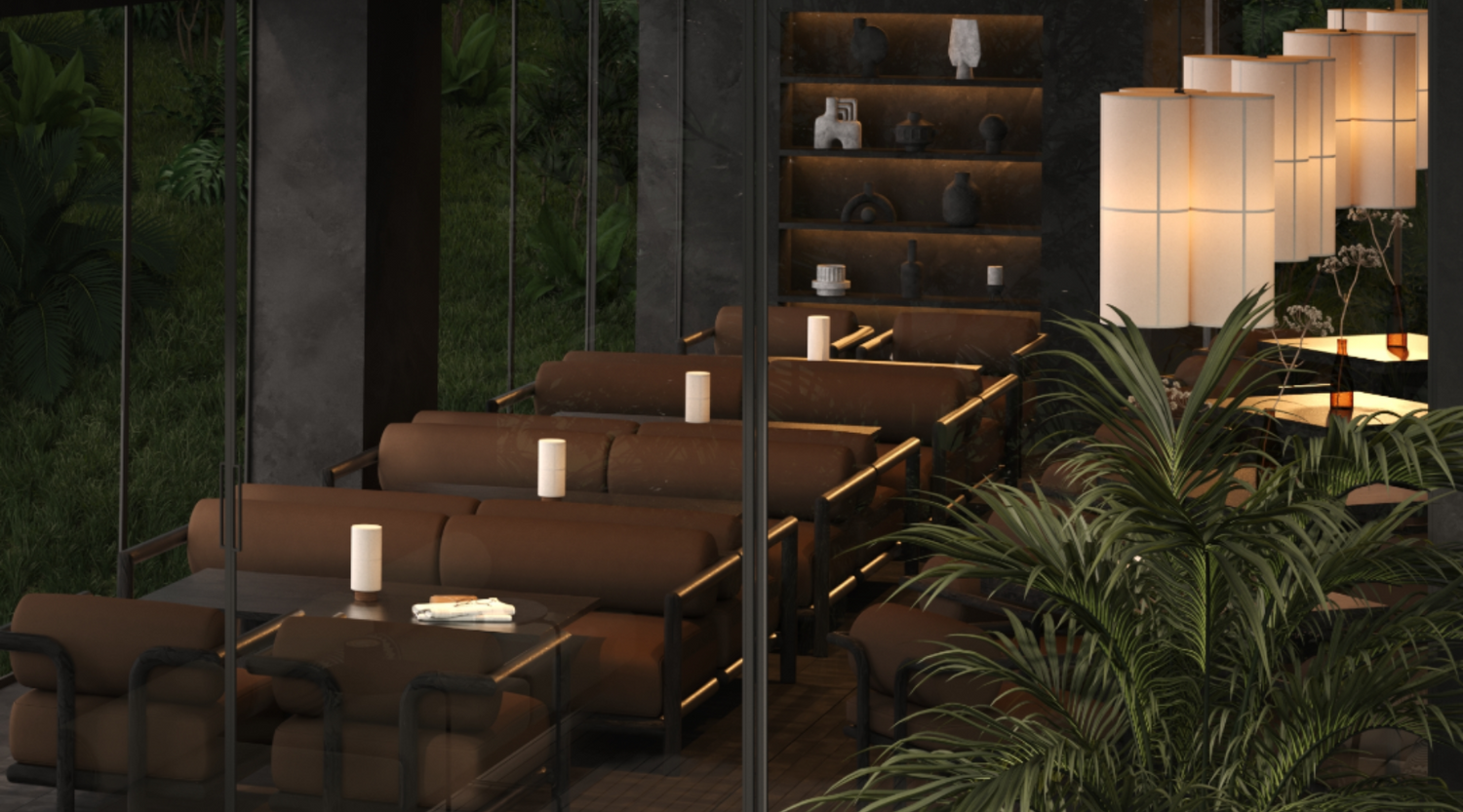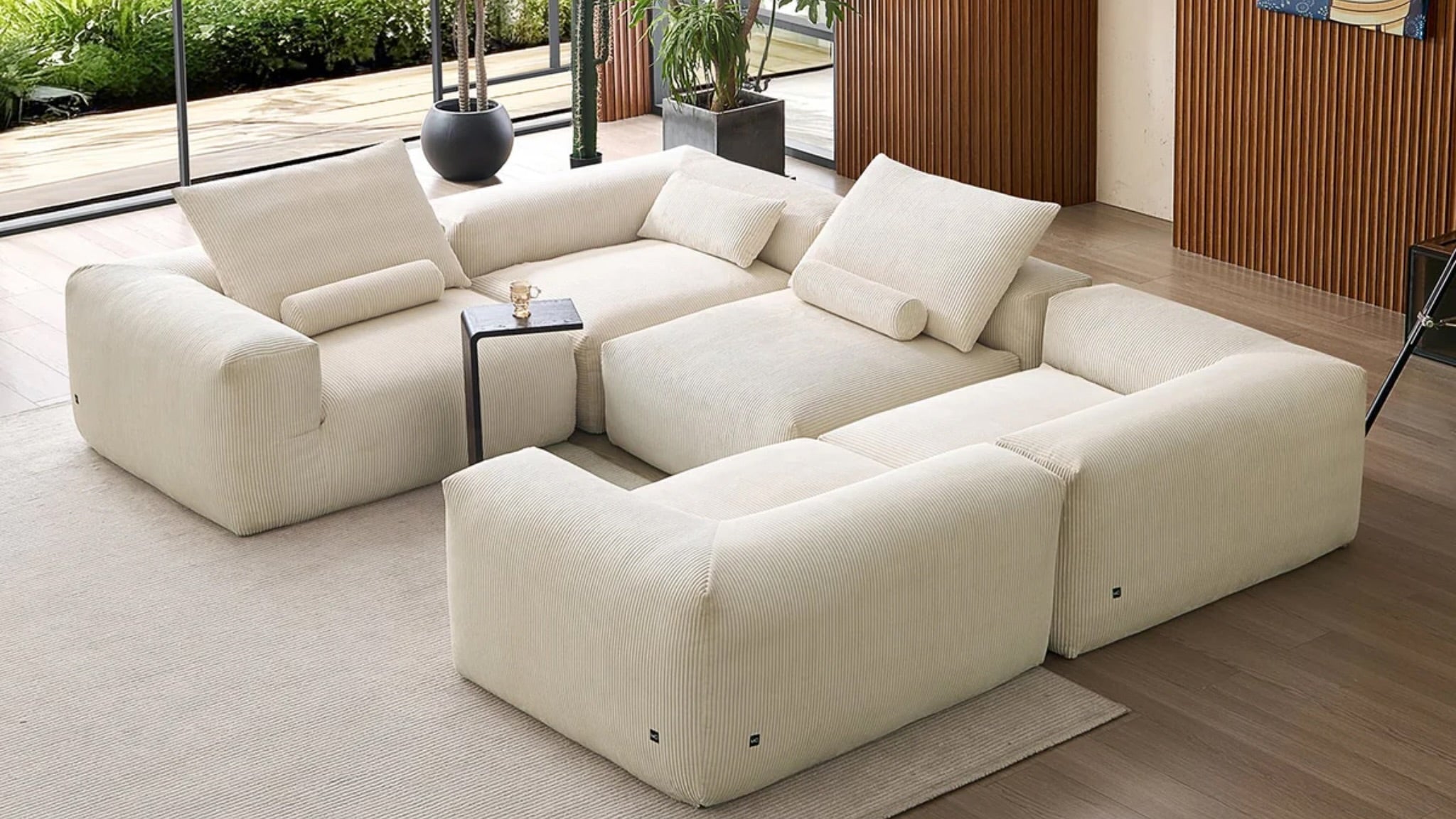Tradition doesn’t disappear—it hides in plain sight. The best interior designers know this. It shows up in proportions, in the weight of wood, in how a room decides where you pause and where you move. When a space borrows the bones of ritual—how a community once sat, served, or dined—it rewires a modern experience almost invisibly.
One restaurant deep in the jungles of Bali channels Japanese restraint through Balinese craft, letting timber, glass, and light behave like cultural memory. Ritual is recoded into a new take of this commercial design space, from pouring sake to breaking bread— which feel both timeless and new.
A Modern Restaurant Design
 Tomei is a boutique resort hotel nestled in the rice fields of Ubud, Bali— where nature, design, and culture meet. At its core is the restaurant, a hybrid of Japanese restraint and modern luxury all in a luminous stage set deep in the jungle.
Tomei is a boutique resort hotel nestled in the rice fields of Ubud, Bali— where nature, design, and culture meet. At its core is the restaurant, a hybrid of Japanese restraint and modern luxury all in a luminous stage set deep in the jungle.
Defined by minimalist glass architecture, serene canopy views, and an on-site sake brewery, the center of cuisine extends this intimacy with farm-to-table menus and Japanese techniques interpreted through Balinese ingredients, all inside a ritualized setting.
The restaurant at Tomei seems to rise from the ground fully formed. Full-height glass walls expose every movement inside, while the rainforest beyond appears composed—a living set piece for the ritual unfolding within.
A Luxury Organic Aesthetic

Geometry is strict: a consistent coffer module runs the ceiling, tables align to that grid, and sight lines pull straight through to the glass perimeter.
Edges are squared and crisp; profiles stay low and grounded. The palette sits in deep earth tones— charcoal andesite walls, graphite concrete, espresso ironwood flooring, and Bangkirai ceiling coffers in warm umber.
Teak solid wood tables introduce a tighter grain and a lighter brown, while leather upholstery lands in tobacco and saddle shades.
Modern and tradition succeed together when each affirms the other’s restraint. Tradition softens modernism’s severity; modern structure elevates tradition’s honesty.
The frame supports tradition’s dialect—groove, grain, join, and differential light. Each element given its moment to resound. In that resonance, the space recasts how you sit, meet, and attend.
Rituals of Dining and Design
 Indonesian architectural history is inseparable from ritualized dining and communal gathering. In Bali, the bale Kulluk and bale Banjar (open-air pavilions) have historically functioned as both civic and culinary spaces, dating back as early as the 11th century during the Warmadewa dynasty.
Indonesian architectural history is inseparable from ritualized dining and communal gathering. In Bali, the bale Kulluk and bale Banjar (open-air pavilions) have historically functioned as both civic and culinary spaces, dating back as early as the 11th century during the Warmadewa dynasty.
Constructed from timber and andesite stone, these structures hosted temple offerings, village feasts, and seasonal harvest rituals, embedding the act of eating within a larger framework of spirituality and community.
The Subach irrigation system, formalized in the 9th century, reinforced this connection, linking agriculture directly to social architecture projects through collective rice cultivation and temple-based feasts.
By the Majapahit period (1293–1527), Javanese palaces integrated dining into community: stone pendopo halls framed banquets, where cuisine was staged as a courtly act and spatial geometry was aligned with ritual order.
If you strip away the temples, palaces, and pavilions, what remains is a cultural instinct: to make space itself an active participant in the act of dining. Walls, ceilings, and thresholds have always carried a social charge— deciding who sits where, how long the feast lasts, and what memories are attached to the table.
That instinct is still alive, not as nostalgia, but as proof that design is never neutral. Every dining room, whether in a palace courtyard or a glass pavilion in the jungle, decides the shape of community.
The Art of Low-Profile

In Indonesian interiors, especially in regions like Java and Bali, furniture has long been more than utility. Hand-shaped without nails, joints followed ancient joinery passed down through families of woodworkers who treated their teak like lineage.
Everyday village homes, however, favored proportion over ornament— lower seat heights for floor-based rituals, wide-set arms for gestural conversation, and subtle flex in rattan or bentwood for breathability in tropical heat.
This restaurant’s furniture carries that lineage forward in a modern idiom. Mid-century chair silhouettes read as descendants of colonial Dutch Indonesian hybrids: soft-angled backs, warm materials, and no hard edges.
Across the room, low-profile armchairs with tubular wood prop the seat up alongside parsons-style dining tables in ebonized wood. Grounded frames emerge from the floor like roots, pulling the act of dining down into something slow, elemental, and close to the earth.
The design language stays consistent: every piece respects the scale of human intimacy— just enough room to lean in, recline back, or place a cup down without distraction.
The Interior Design Firm

Mario Capasa Group treats interiors as a coordinated system, managing every stage of design, from planning and FF&E to furniture design, décor, and staging, while producing drawings, schedules, and design layouts that bring those spaces together as complete environments.
The interior designers at Mario Capasa have expertise in modular seating systems— refined in the direct-to-consumer market through its luxury couches and sectionals finds a successful translation in the restaurant space for this project.
The Restaurant Interior Design

The same philosophy that drives their modular couches for homes, with interchangeable units, customizable layouts, and high-performance upholstery, is applied here to create seating that adapts to flow, intimacy, and scale.
In the restaurant, low-set pieces anchor communal areas while sectional-style arrangements allow zones to flex between private dining and open lounge configurations.
The psychology of seating can influence how long a guest stays— and even how much they order. In restaurant design, plush, upholstered furniture like the low-set modular pieces seen here doesn’t just signal comfort— it encourages lingering.
Research shows that diners are more likely to order dessert or a second glass of wine when their posture is reclined and unhurried. Compare that to stiff wooden chairs, which tend to subconsciously signal “quick bite.” The deeper the seat, the deeper the check.
This approach brings the comfort and adaptability of residential luxury furniture into a hospitality setting, encouraging dwell time, shaping guest posture, and ultimately enhancing dining as both ritual and experience.
Japan-Bali Design Concept
 Every line of the room nods to Japan’s obsession with ritual dining. Balinese craft shows up in the bones — bamboo worked with joinery discipline.
Every line of the room nods to Japan’s obsession with ritual dining. Balinese craft shows up in the bones — bamboo worked with joinery discipline.
One culture brings weight, the other openness, and the design forces them into the same frame without apology. Its design language — dark timber, rectilinear frames, an emphasis on finished wood as a tactile surface — sits in a continuum with that Balinese tradition.
Now, in this contemporary design restaurant, that lineage translates into heavy wood flooring, paneled shelving, and joinery that highlights wood’s density and permanence.
The throughline is this: in Balinese culture, wood isn’t just material; it’s a cultural surface, a medium where artistry, ritual, and daily life are inscribed. The restaurant carries that idea forward— wood as an anchor, as historical and a tactile constant.
Lighting carries its own cultural inflection. The paper-like lanterns draw from Japanese shōji traditions, yet their soft glow resonates with Balinese temple offerings, where candles and oil lamps illuminate carved shrines at dusk. This hybrid creates a cultural bridge — Japanese in geometry, Balinese in atmosphere — that situates the restaurant within both lineages.
Interior Layout Renews Dining Ritual
 Balinese dining culture has long merged cuisine with design, treating interiors as active participants in ritual. That lineage is evident in the design of the restaurant experience — pulling the act of dining down into something slow, elemental, and close to the earth.
Balinese dining culture has long merged cuisine with design, treating interiors as active participants in ritual. That lineage is evident in the design of the restaurant experience — pulling the act of dining down into something slow, elemental, and close to the earth.
Beyond the glass, the canopy presses close — dense, sacred, and vast. Its presence is unignorable, like a silent witness outside the pavilion, drawing the diners inward until the meal becomes a small act of devotion and a kind of soulful communion.
About Mario Capasa
Mario Capasa Group is a Furniture Retailer and Interior Design Studio recognized for its modern interior design trends and turnkey design services.
Specializing in seating systems—including modular couches, sectional sofas, and interior décor—the studio works across residential, commercial, and hospitality projects worldwide. From home staging to international design concepts, Mario Capasa delivers modern design that balances cultural heritage with contemporary living.





Leave a comment
This site is protected by hCaptcha and the hCaptcha Privacy Policy and Terms of Service apply.